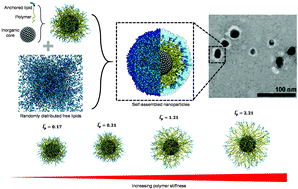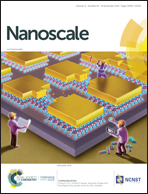Polymer stiffness governs template mediated self-assembly of liposome-like nanoparticles: simulation, theory and experiment†
Abstract
This study suggests that the self-assembly of a template-mediated liposome (TML) can be utilized as a general method to produce liposomes with controlled sizes. A polymer tethered core is used here as a starting configuration of a TML. Lipids anchored to the free ends of the tethered polymers direct the self-assembly of surrounding free lipid molecules to form liposome-like nanoparticles. Characterizing the flexibility of polymers by their persistence lengths, we performed large scale molecular simulations to investigate the self-assembly process of TMLs with tethered polymers of different stiffness values. The stiffness of tethered polymer is found to play a crucial role in the self-assembly process of TMLs. The flexible and rigid-like polymers can accelerate and delay the self-assembly of TMLs, respectively. In addition, the critical grafting of tethered polymers and required lipid concentrations to from perfectly encapsulated TMLs are found to increase with the flexibility of tethered polymers. To scrutinize these simulation-based findings, we synthesized DNA-polyethylene glycol (PEG) TMLs and performed corresponding experiments. To this end we incorporate increasing concentrations of DNA as a proxy for increasing the rigidity of the tethered polymers. We find that the resulting structures are indeed consistent with the simulated ones. Finally, a theory is developed that allows one to estimate the required free lipid number (or lipid concentration) and grafting density analytically for polymers of a given persistence length. Through these combined computational, experimental, and theoretical studies, we present a predictive model for determining the effect of polymer stiffness on the self-assembly of TMLs, which can be used as a general approach for obtaining perfectly encapsulated TMLs as potential drug delivery vehicles.

- This article is part of the themed collection: Theoretical Modelling at Nano-bio Interfaces


 Please wait while we load your content...
Please wait while we load your content...